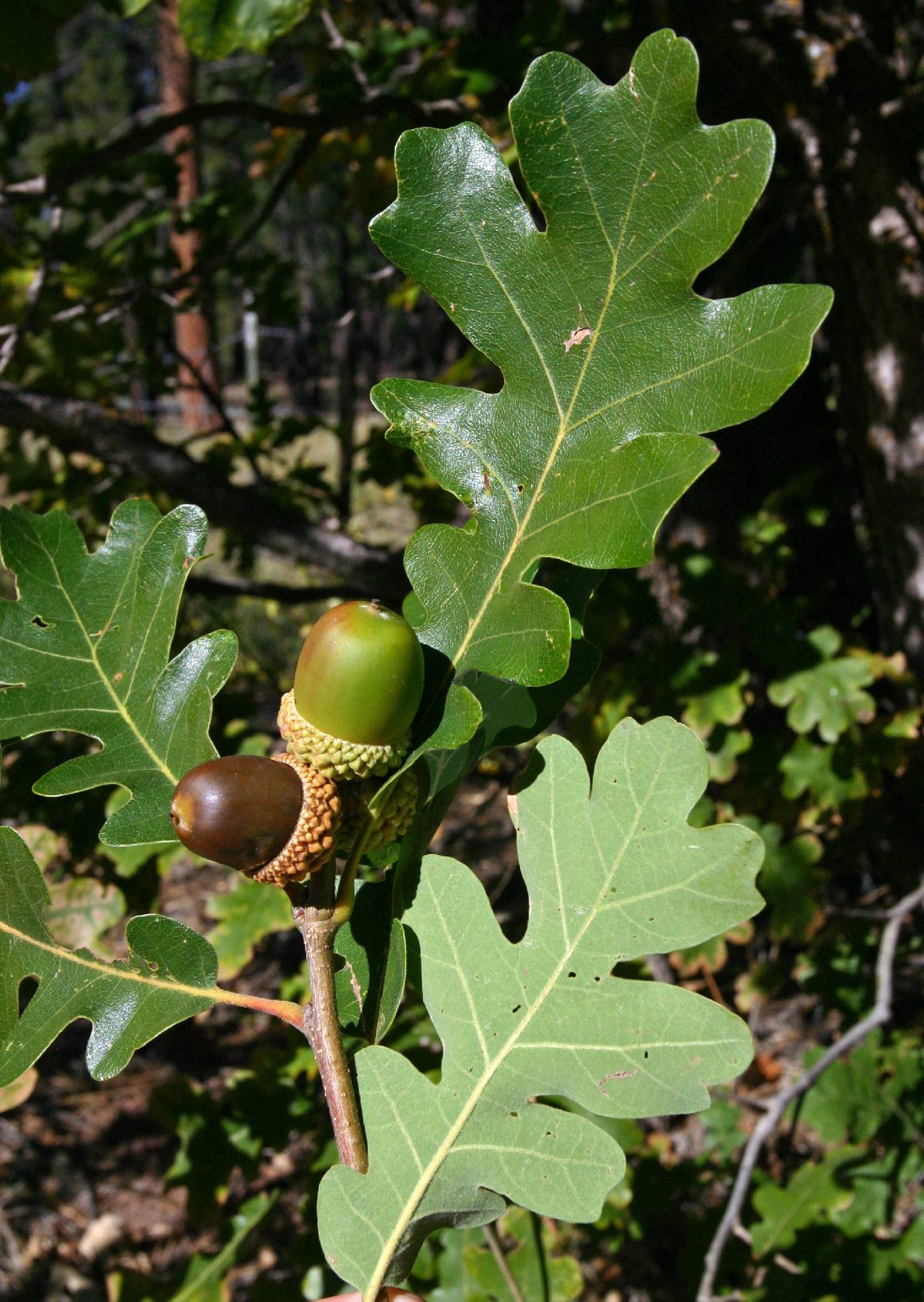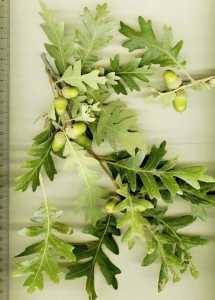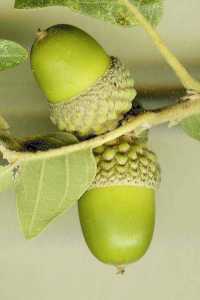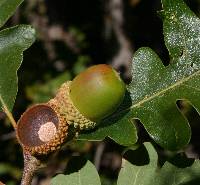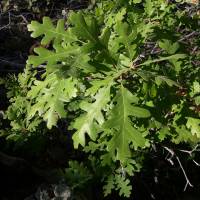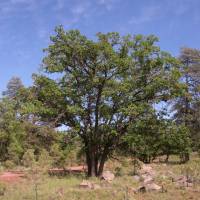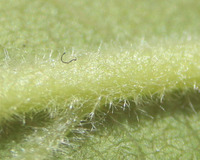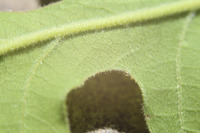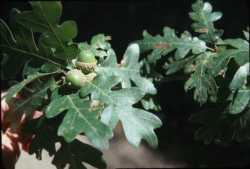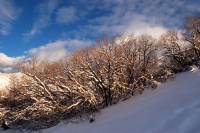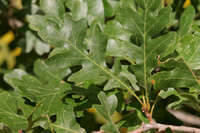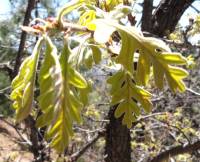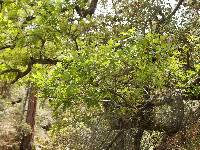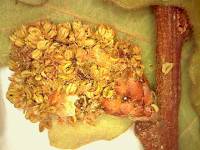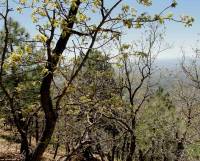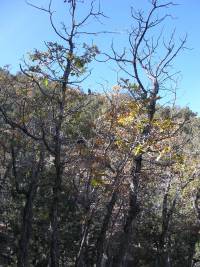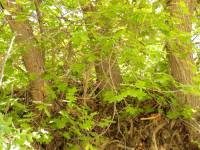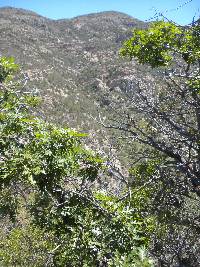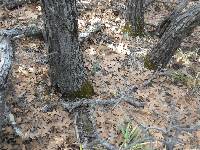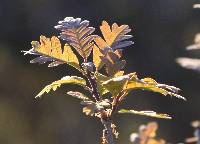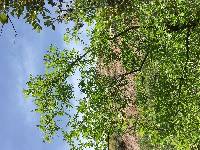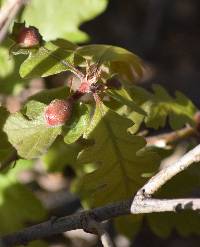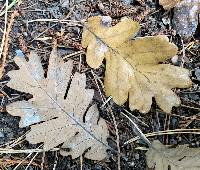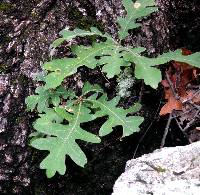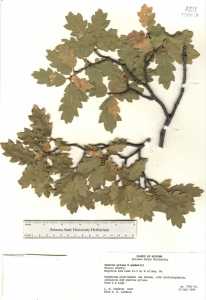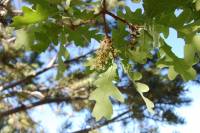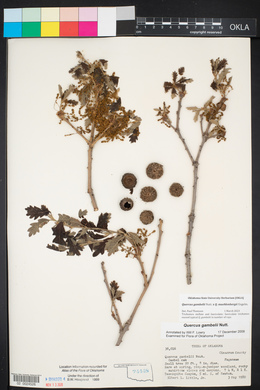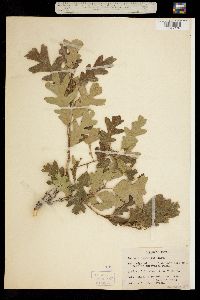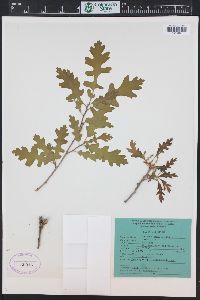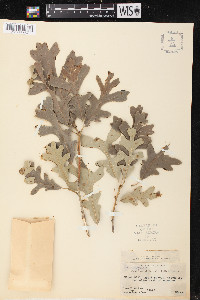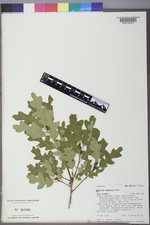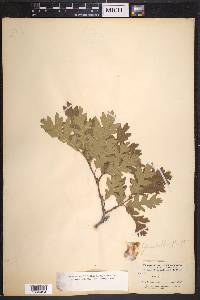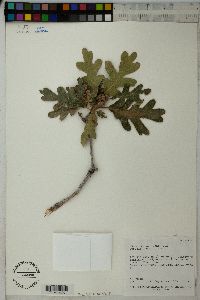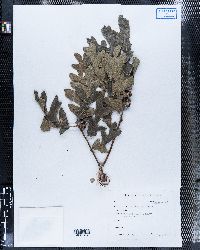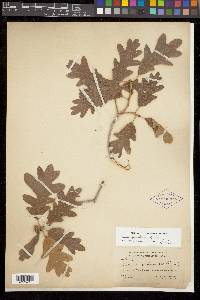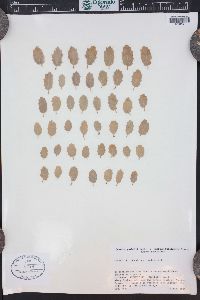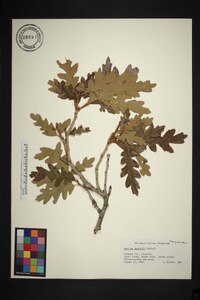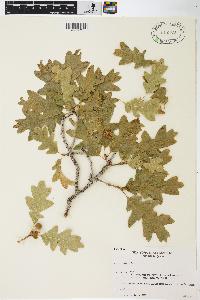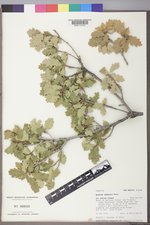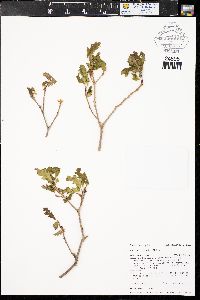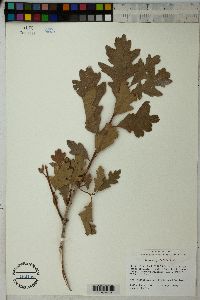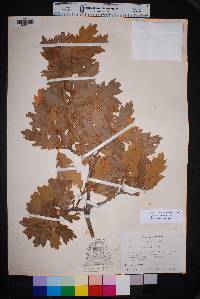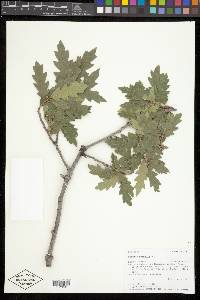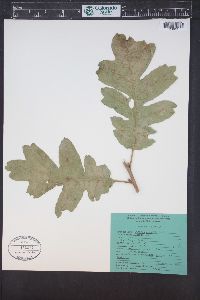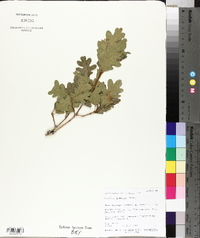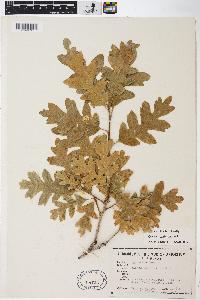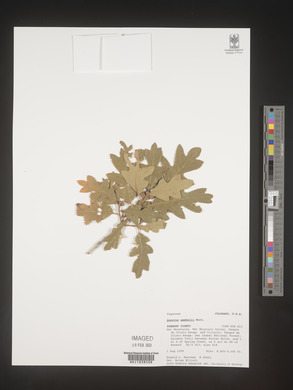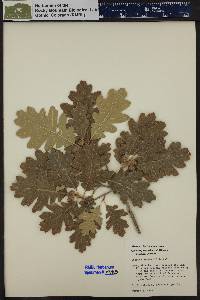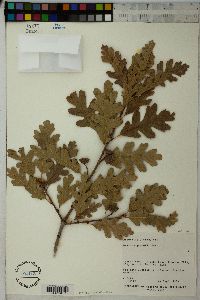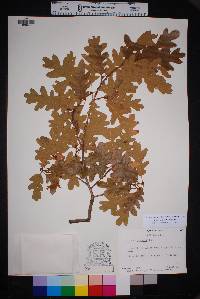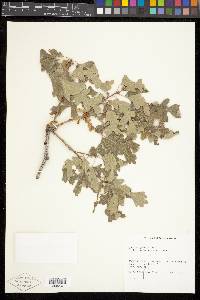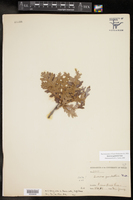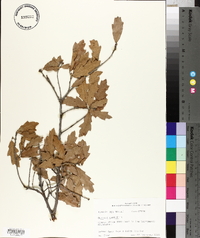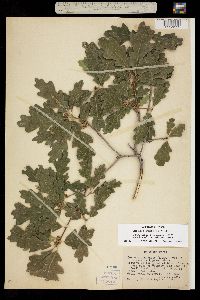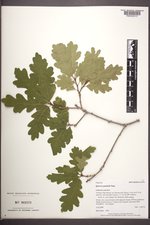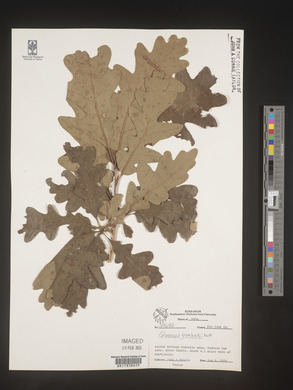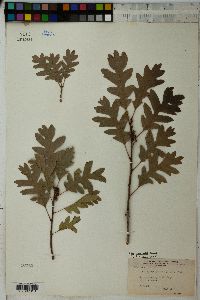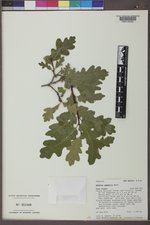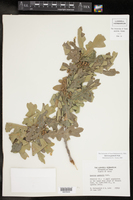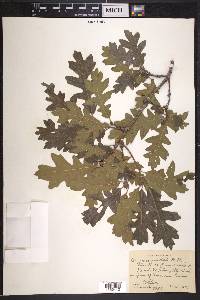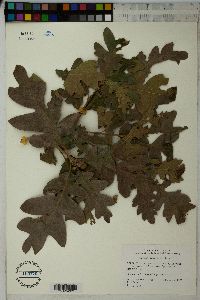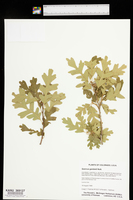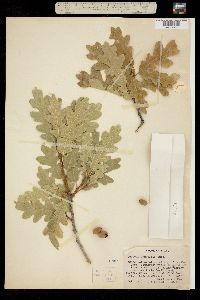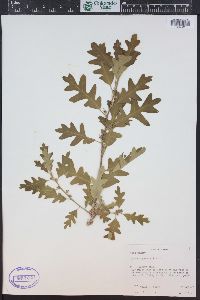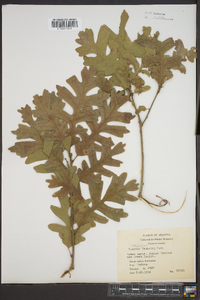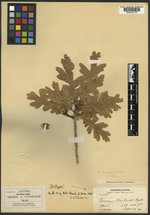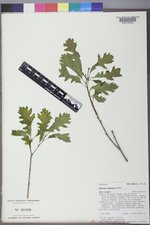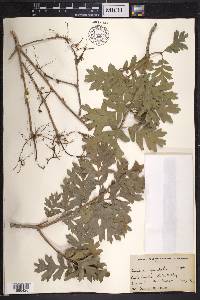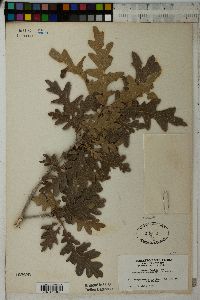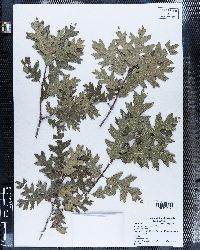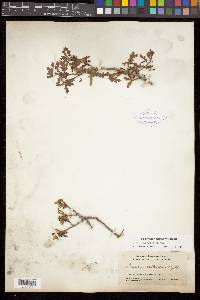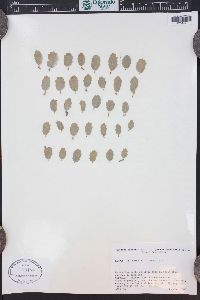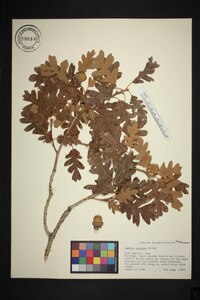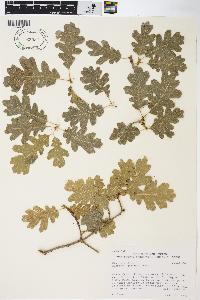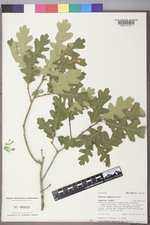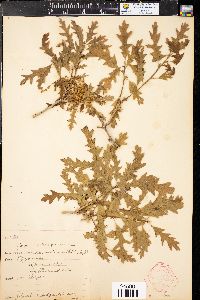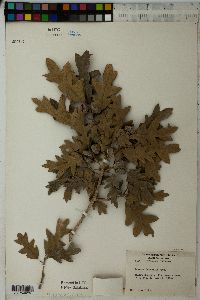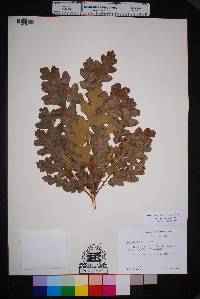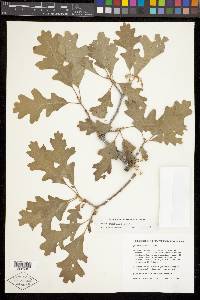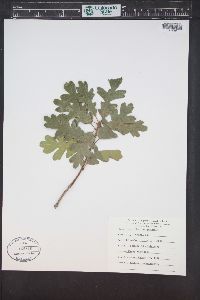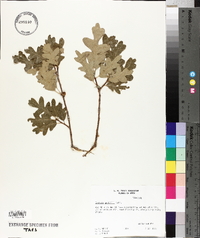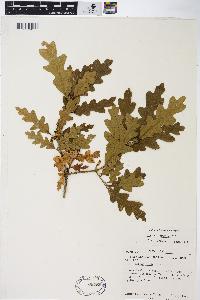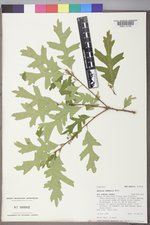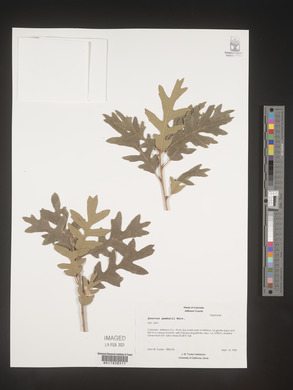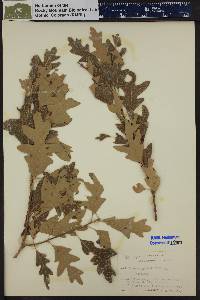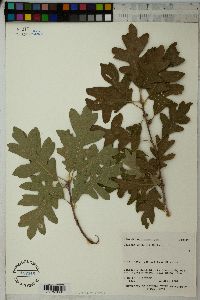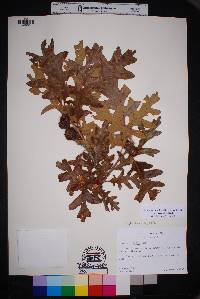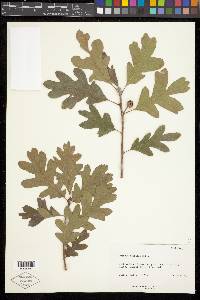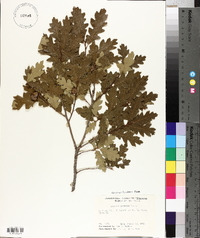Quercus gambelii
|
|
|
|
Family: Fagaceae
Gambel's Oak, more...Gambel oak
[Quercus albifolia C.H.Mull., moreQuercus gambelii var. utahensis (A. DC.) Garrett, Quercus gambellii Liebm., Quercus marshii C.H.Mull., Quercus undulata var. gambelii , Quercus undulata var. gunnisonii] |
Shrubs or trees , deciduous, shrubs sometimes clumped and spreading, trees small or moderately large. Bark gray or brown, scaly. Twigs brown or reddish brown with few, inconspicuous lenticels, 1.5-2.5 mm diam., glabrous or stellate-pubescent. Buds brown, ovoid, ca. 3 mm, apex acute or obtuse, sparsely pubescent, becoming glabrate. Leaves: petiole l0-20 mm. Leaf blade elliptic to obovate or oblong, deeply to shallowly 4-6-lobed, (40-)80-120(-160) × (25-)40-60(-100) mm, membranous, base truncate to cuneate, margins entire or coarsely toothed, lobes oblong, rounded or subacute, sinuses acute or narrowly rounded at base, reaching more than 1/2 distance to midrib, secondary veins 4-6 on each side, each passing into lobe, branched, apex broadly rounded; surfaces abaxially dull green, sometimes glaucous, densely velvety with erect 4-6-rayed hairs, sometimes glabrate or persistently villous only near midribs, secondary veins prominent, adaxially lustrous dark green, appearing glabrate, microscopically pubescent, secondary veins slightly raised. Acorns solitary or paired, subsessile or on peduncle to 10(-30) mm; cup deeply cup-shaped, 5-8(-17) mm deep × 7-l5(-25) mm wide, enclosing 1/4-1/2 nut, base round, margin thin, scales closely appressed, ovate, markedly tuberculate, proximally gray-tomentulose; nut light brown, ovoid to ellipsoid, (8-)12-15(-33) × 7-12(-18) mm. Cotyledons distinct. Flowering mid-late spring. Montane conifer, oak-maple, and higher margins of pinyon-juniper woodlands; 1000-3030 m; Ariz., Colo., Nev., N.Mex., Okla., Tex., Utah, Wyo.; Mexico (Chihuahua, Coahuila, and Sonora). Numerous hybrids of Quercus gambelii with various scrub oaks have been reported, including Q . grisea and Q . turbinella . Such hybrids in general have shallowly lobed or dentate, semipersistent leaves and intermediate characteristics of pubescence and fruit between parental types. Such hybrids are usually referred to as the Quercus × undulata complex because of widespread application of the latter name to various populations. One population from San Juan County, Utah, with larger fruit but otherwise not differing from typical Quercus gambelii , has been recognized as Q . gambelii var. bonina Welsh. Unless other characters are found to support this segregation, the plants are best not treated as a formal taxon, particularly considering the extensive variation and hybridization associated with Q . gambelii throughout its range. Numerous putative hybrid swarms occur throughout the range of Quercus gambelii that involve a number of suspected parental species. Most of these populations have, at one time or another, been referred to Quercus undulata Torrey. The putative hybrids have serrate or shallowly lobed leaves and considerable variation in habit, leaf pubescence, and acorn morphology. J. M. Tucker (1961, 1969, 1971) and J. M. Tucker et al. (1961) have identified the major components of the Q . undulata complex as Q . turbinella (western Utah and northwestern Arizona, and central Colorado), Q . grisea (New Mexico and southern Colorado), Q . havardii (southeastern Utah and northwestern Arizona), Q . mohriana (northeastern and southern New Mexico), Q . arizonica (central Arizona), and Q . muhlenbergii (eastern and central New Mexico). Quercus macrocarpa has been implicated as a parent of variable populations in New Mexico (J. M. Tucker and J. R. Maze 1966). Because of the complex variability in these populations, no effort has been made to treat them separately here; indeed, it would be impossible to produce usable keys if these were included as formal taxa. Hybrids derived from Quercus gambelii and an evergreen species are often semideciduous, retaining a variable portion of green or brownish leaves over the winter. Quercus gambelii was used medicinally by the Navaho-Ramah to alleviate postpartum pain, as a cathartic, as a ceremonial emetic, and as a life medicine (D. E. Moerman 1986).
Plant: tree; to ca. 12 m high, the bark light gray, with longitudinal fissures between plates; young twigs thinly grayish pubescent, dark reddish brown, the older twigs glabrescent, light brown or gray Leaves: lobed, elliptic in outline, 4-17 cm long, 3-12 cm wide, 1.2-1.9 times as long as wide, thinly pubescent below (especially along the veins), thinly pubescent to subglabrous above, deciduous at end of first summer, the lobes 2-4(-6) per side (sometimes lobed themselves), the sinuses between lobes reaching about 30 to 90% of the way to the midvein; stellate hairs of lower leaf surface with 2-4(-5) arms; apex obtuse to rounded; base cuneate to attenuate; petiole 0.3-2 cm long, pubescent to subglabrous; midvein nearly flat or raised above, prominent below; lateral veins up to ca. 8 pairs, nearly flat above, raised below; secondary veins clearly visible and flat above, somewhat raised below; blade subcoriaceous, lustrous or dull above, drying dark yellow-green or olive green, somewhat darker above than below; margin aside from lobes entire, flat INFLORESCENCE: staminate flowers in aments; pistillate flowers solitary or in groups on spikes, these sometimes abbreviated, each pistillate flower with a separate involucre Flowers: mostly wind-pollinated, unisexual, the perianth much reduced or absent; staminate flowers in heads or aments, the perianth greenish, the stamens 5-7; pistillate flowers usually tricarpellate, solitary or in clusters of about 3 or more, subtended individually or in groups by an involucre that develops into a woody cupule enclosing or subtending the mature fruit(s) Fruit: ACORNS 1.8-2.7 cm long, solitary or clustered in 2's and 3's; cap nearly hemispheric, 8-12 mm long, 15-18 mm wide, the inner surface densely appressed pubescent, the hairs about straight; scales with thickened bases; nut-shell thinly pubescent (more densely so apically) to subglabrous within Misc: In forests, usually associated with ponderosa pine; 1200-2900 m (3900-9700 ft); Apr-Jun (fr. Aug-Oct) REFERENCES: Landrum, Leslie R. Fagaceae. 1994. J. Ariz. - Nev. Acad. Sci. Volume 27, 203-214 Landrum 1993 Common Name: Gambel oak Duration: Perennial Nativity: Native Lifeform: Tree Wetland Status: UPL General: Usually a tree that can reach 12 m in height, the bark is longitudinally fissured and light gray, younger twigs can be reddish brown and gray. Leaves: Deeply lobed 2-4 per side, the overall leaf is more elliptic in outline 4-17 cm long, 3-12 cm wide, 1-2 times as long as wide, thinly pubescent below, pubescent to subglabrous above, deciduous at the end of summer. The apex is rounded and the leaf is lustrous green above and strongly veined below. Flowers: Staminate aments with reduced perianth parts, 4-12 stamens; pistillate flowers solitary or in clusters of 2-3; inferior ovary. Fruits: The acorns are 1.5-2.5 cm long, solitary to clustered in 2 or 3, the cupule is hemispheric 8-12 mm long and both are less than 2 cm wide. Ecology: Found in forests, generally in association with ponderosa pine at higher elevations from 4,000-10,000 ft (1219-3048 m), flowers in April-June. Distribution: Ranges across the intermountain west to Wyoming and south into northern Mexico. Notes: The gently lobed margins are distinctive among the oaks in the region. It is also the most clearly associated species with higher elevation forests. Horrible hybridizer! Ethnobotany: The nuts were used as food, as ceremonial emetics, as an analgesic for pain, as a crude Viagra, it was ground into meal, eaten raw, stored, boiled, made into mush and flour. The wood was used as fuelwood, for furniture, other building materials, toys, ceremonial items, and other household implements. Etymology: Quercus is the classical Latin word for oak, thought to be derived from Celtic quer, fine, and cuez, tree, while gambelii is named for William Gambel (1821-1849) an assistant curator at the National Academy of Sciences. Synonyms: None Editor: SBuckley 2012 |
|
|
|

